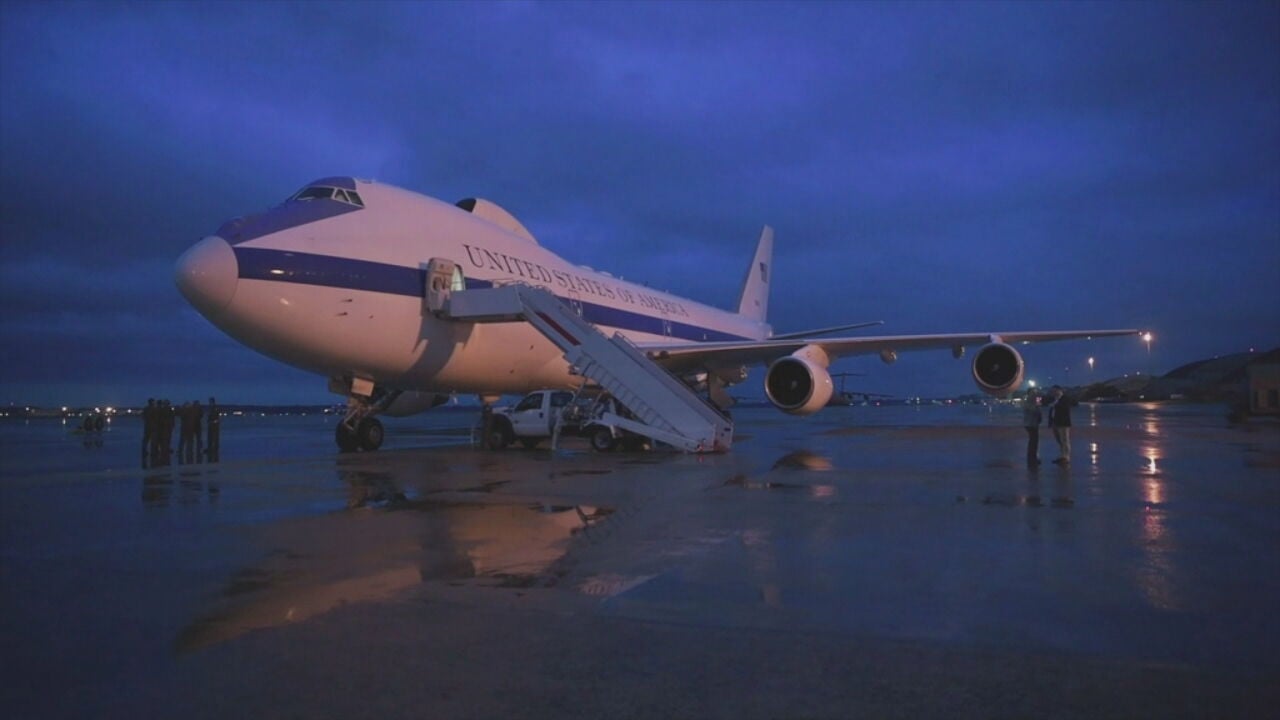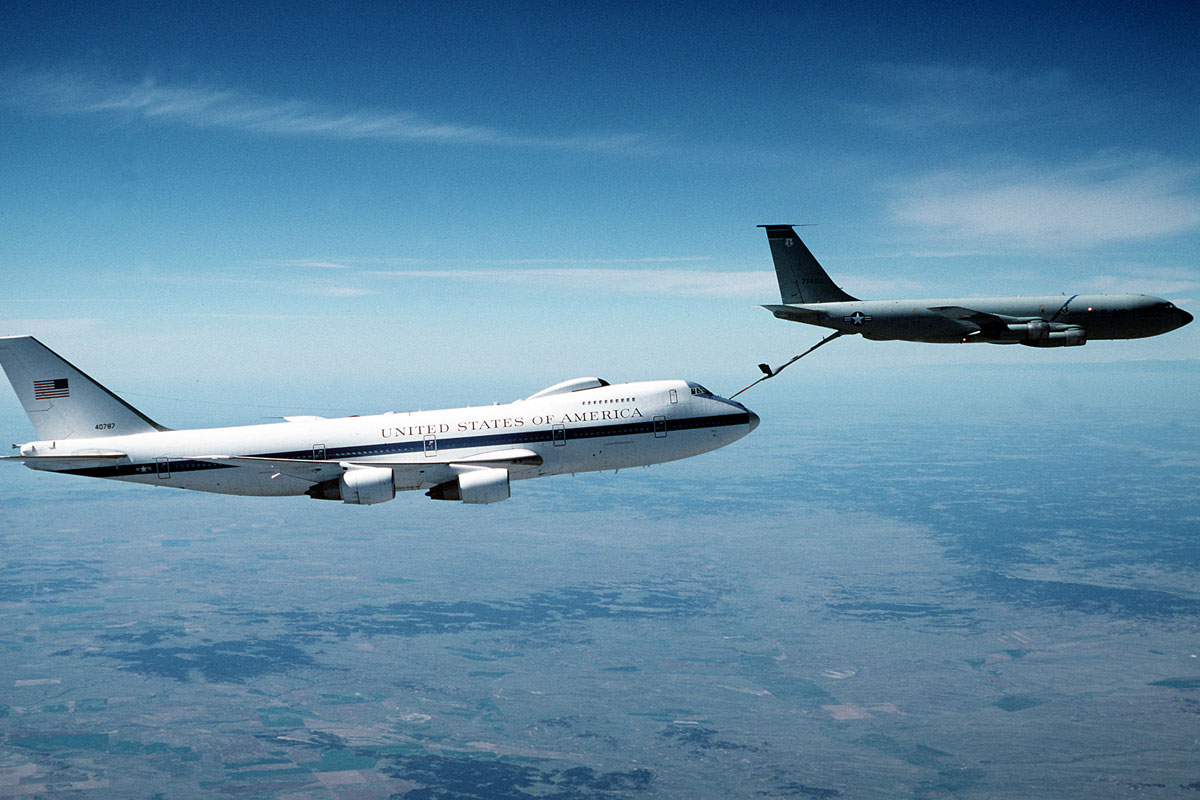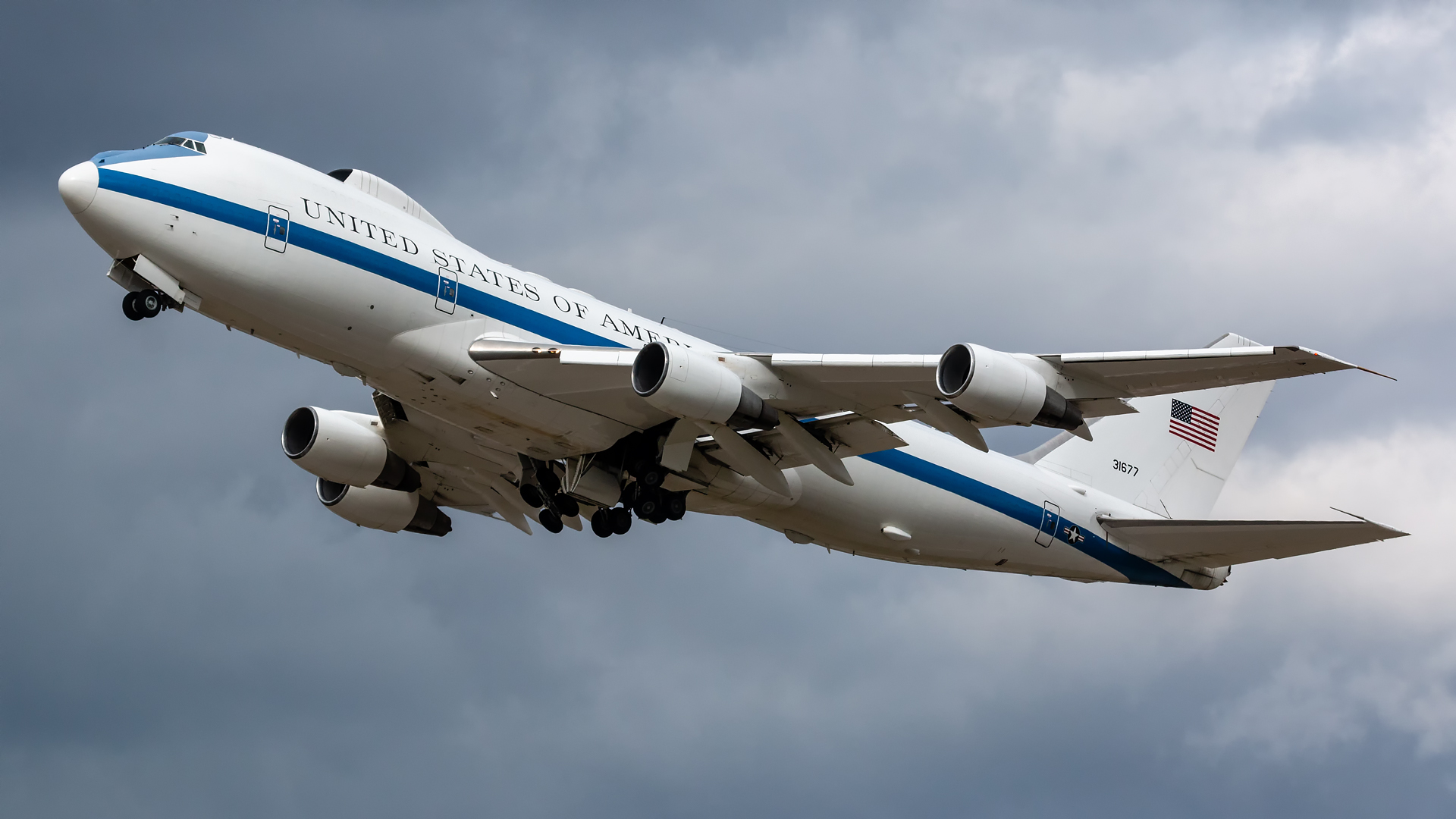Nightwatch Aircraft - Is a strategic command and control military aircraft operated by the United States Air Force (USAF). The E-4 series is specially adapted from the Boeing 747-200B for the National Aviation Emergency Control Post (NEACP) program. The E-4 serves as a surviving mobile command post for the national command authority, namely the President of the United States, the Secretary of Defense, and successors. The four E-4Bs are operated by the 1st Air Command and Control Squadron of the 595th Command and Control Group based at Offutt Air Force Base, near Omaha, Nebraska. E-4B is in operation at National Aircraft Operations Cter.
Two of the original 747-200 airframes were originally designed to be commercial aircraft. When the airline did not complete the order, Boeing offered the airframes to the United States. Under the NEACP's 481B program the Air Force Electronic Systems Division awarded a contract to Boeing in February 1973 for two unequipped aircraft, designated E-4A, powered by four P&W JT9D Gines, to which a third aircraft was added in July 1973. 4A completed in July 1973. Boeing factory outside Seattle, Washington in 1973. E-Systems won the contract to temporarily equip the three aircraft, and the first completed E-4A was delivered in July 1973 to Andrew Air Force Base, Maryland. The next two were introduced in October 1973 and October 1974.
Nightwatch Aircraft

The third E-4 was delayed by being powered by the GE F103 Gine, which was later made standard and retrofitted to the previous two aircraft. The A model had essentially the same equipment as the EC-135, but offered more space and the ability to stay higher than the EC-135.
Inside The Plane That Follows Donald Trump's Air Force One
In November 1973, it was reported that the total cost of the program was estimated at $548 million (equivalent to $3.35 billion in 2021) for SEW 747s, with six as operational management positions and another for research and development.
A fourth aircraft was ordered in December 1973; It had more advanced equipment, leading to the designation E-4B. On December 21, 1979, Boeing introduced the first E-4B (serial number AF 75-0125),
Distinguished from the earlier version by the press of a large, streamlined radome on the dorsal surface just behind the upper deck. This includes the aircraft's cooktop satellite dish.
The E-4B offered a huge increase in communications capability compared to the previous model and was considered to be 'hardened' against the effects of a nuclear electromagnetic pulse (EMP) from a nuclear explosion. Hardening the aircraft meant that all equipment and wiring on board was shielded from EMP.
A Look Inside The Us's $223 Million Doomsday Plane
In 2005, the Air Force awarded Boeing a five-year, $2 billion contract (equivalent to $2.77 billion in 2021) for the ongoing upgrade of the E-4B fleet.
In addition to the purchase and upgrade costs, the E-4 costs the Air Force nearly $160,000 per hour (equivalent to $180,654 in 2021) to operate.
And has state-of-the-art direct fire countermeasures. Although many older aircraft have been upgraded with glass cockpits, the E-4B still uses traditional analog flight instruments, as they are less vulnerable to damage from an EMP blast.

The E-4B can operate with a crew of up to 112 people including flight and mission personnel,
Trump's 'doomsday' Plane Is A Flying Nuclear Bunker
The largest crew of any aircraft in the United States. it is. History of the Air Force. With air refueling in flight, it can remain in air for a considerable period, limited only by the use of engine lubricants. In a test flight for a period, the aircraft remained in the air and fully operational for 35.4 hours, but was designed to remain in the air for a full week in the event of an emergency.
It takes two fully loaded KC-135 tankers to fully refuel an E-4B. The E-4B has three operational decks: upper, middle and lower.
The flight deck includes stations for the pilot, co-pilot and flight engineer, along with a special navigation station not normally found on commercial Boeing 747s. There is a lounge and sleeping quarters for flight and maintenance crews behind the flight deck. The flight crew consists of an aircraft controller, co-pilot, navigator and flight engineer.
The middle deck contains the conference room, which provides a secure space for conferences and briefings. It includes a conference table for nine people. Behind the conference room is a projection room which serves the conference room and the briefing room. The projection room has the ability to project computer graphics, overhead transparencies or 35mm slides into the conference room and/or briefing room, but has since been modernized with flat screen displays.
Interesting Facts About The Us Doomsday Plane
The combat staff includes various commanders, planners, aircraft systems officers, communications operators, a weather officer, administrative and support personnel, and a combat chief of staff. A general officer with two staff officers controls Operation Looking Glass missions, while the National Air Force Operations Command (NAOC) can reassign and initiate a member of the National Command Authority (NCA) from an undisclosed location. There are at least 48 crew on any E-4B mission.
Behind the briefing room is the operations team area with the automatic data processing equipment and seats and console workstations for 29 members of staff. The consoles are configured to provide access to or from the automated data processing, automatic switchboard, direct access telephone and radio circuits, direct ("hot") lines, monitoring panel for switchboard lines, staff and operator between telephone and an audio recorder.
The aft section on the S of the main deck is the technical control area (technology control). This area was the nerve-wrecker for all communications and communication technicians. Typically 3 of the 6 crew positions are occupied here by specialist US. it is. Air Force technicians are responsible for proper monitoring and distribution of all communications power, cooling and reliability. The technical manager number 1 (Tech 1, TC1) was the direct interface with the aircraft flight engineer and flight crew. This position was also the main focal point for all matters relating to communication. Technical Controller No. 2 (Tech 2, TC2) was responsible for maintaining all very high frequency communications between the aircraft and Nightwatch GEP (Ground try Points). The GEPs provided 12 voice lines to the aircraft which were used in the day to day operations of the mission. Secure voice is also provided. The SHF operator (or technician) maintained the SHF satellite link and provided other global communications services probably replacing many UHF capabilities.

The rest area, which occupies the remaining part of the main deck, provides a resting and sleeping area for the crew members. The rest area includes storage for food
File:e 4b Nightwatch.jpg
In the forward test area is the main galley unit and the stairs to the flight deck and to the lower forward equipment area. This area contains fridges, freezers, two convection ovens, and a microwave oven to give stewards the ability to provide more than 100 hot meals during long journeys. In addition, four seats are located on the left side of the test area forward for the security guards and the manager.
Behind the forward test area is the National Control Authority (NCA) area, which has been designed and furnished as a working suite. It includes an office, lounge, sleeping area and dressing room. Telephone equipment in this area provides the NCA with secure and clear global communications.
The briefing room includes a briefing table with three executive seats, eight additional seats, a lectern and two 80 inch flat screen LED monitors mounted directly on the partition.
The communication control area is divided into a voice area and a data area. The voice area, located on the right side of the compartment, includes the radio operator's console, the semi-automatic switchboard console and the communications officer's console. The data area, located on the left side of the area, contains the records communication console, data recording supervisor console, high speed DATA / AUTODIN / AFSAT console and LF / VLF control heads. The E-4B can communicate with the ground over a wide range of frequencies covering almost tire radio communication spectrum from 14 kHz to 8.4 GHz. Ground stations can connect the E-4B in the main US. it is. A communication network on earth.
Boeing E 4b Nightwatch [add On]
The flight avionics area includes aircraft systems power panels, flight avionics equipment, liquid oxygen converters and storage for baggage and spare parts.
The lower forward equipment room contains the aircraft's water supply tanks, 1200 kVA electrical power panels, step-down converters, VLF transmitter and SHF SATCOM equipment. An AC/DC powered retractable hydraulic airstair is located on the right forward side of the lower forward equipment area, set up for flight test and egress. In the second of emergency, the air stairs can be dropped. The rear lobe contains the maintenance console and mission specific equipment.
The lower trailing wire antenna (TWA) area includes the aircraft's 5-mile-long (8.0 km) TWA coil—used by up to 13 communications links—the antenna operator's station, as well as antenna coil controls and indicators. A lot of attention has been paid to hardening the area against EMP, especially since the TWA, which is essential for communication with Ohio-class ballistic missile submarines, is also particularly effective at picking up EMP.

What was known as the National Emergency Aircraft Control Post (NEACP) (often
Doomsday Planes, E 4b Nightwatch Are Grounded, Forcing Defense Secretary To Use Other Military Jets
Aircraft appraisal online, free aircraft appraisal, aircraft appraisal services, aircraft appraisal cost, aircraft appraisal jobs, aircraft appraisal course, aircraft appraisal training, business appraisal, rolex appraisal, appraisal software, 409a appraisal, aircraft appraisal report
Post A Comment:
0 comments so far,add yours